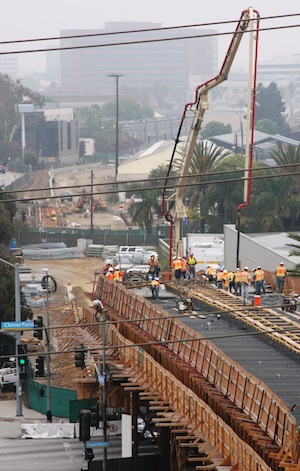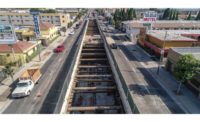
A Los Angeles light rail line being expanded by Skanska USA faces a court challenge that could shut down work.
The state Supreme Court is scheduled to hand down a decision by Aug.7 in a challenge by local residents to Phase II of the Los Angeles Exposition Rail line, now under construction through the city’s west side and due to start operating in 2015.
The main issue is whether a construction authority has the discretion to use existing or future conditions when it evaluates the environmental impacts of a project.
“There are projects up and down the state that this decision will affect in how they are planned and permitted,” says Robert Thornton, an environmental lawyer in Irvine, Calif., and counsel for the Expo Line Construction Authority.
There is certainly a level of anxiety among stakeholders and construction firms when a multi-billion dollar project faces court opposition. “It’s a wait-and-see game at this point,” says Steven S. Rados, president of Steve P. Rados Inc., Santa Ana, a partner with Skanska on the project. “If a stay were ordered, there would have to be a meeting with [the rail authority] and I really don’t know what would happen.”
“It’s always a possibility that a project could be stopped,” Thornton says. “If the [superior court] decided in favor of the project opponents, the case would return to the trial courts where a variety of remedies would be argued and further analysis of the project could be imposed.”
ENR asked Rados if there were insurance precautions other risk management strategies that firms can take when it comes to cases challenged in court. “There’s really no way to prepare for something like this. Unless there are some very unusual circumstances, we assume that [the owner] has ‘dotted its I’s and crossed its T’s,’” he says.
Aiming for Santa Monica
The Expo line currently runs between downtown Los Angeles and Culver City and it is scheduled to begin service in 2016 on the new branch to Santa Monica. As lead contractor, Skanska USA’s contract is worth about $560 million, the contractor said last year.
Expo’s environmental impact report compared projected traffic and air quality conditions with and without the project in 2030, but the “authority exercised its discretion to use projected and future conditions” to gauge the impact of the light rail’s operation because the full effects would not be manifest until 2030, Thornton says.
In response to lawsuits by opponents aimed at blocking the project in state superior and appeals courts, judges upheld the idea that under those circumstances basing the project’s impact on existing traffic and air conditions was moot.
After losses in superior and appeals courts, however, a superior court judge accepted a lawsuit from Los Angeles-based Neighbors for Smart Rail in August and oral arguments were heard on May 7. In October, Neighbors for Smart Rail asked the court to stop construction on Phase II, arguing that a win for its side would be empty victory if work continued or was completed by the time of a ruling.
The stay request, however, was rejected. “It’s a good sign,” Thornton says.
Skanska USA said it was hopeful that the court would uphold the prior decisions in favor of the project.
“Obviously, we hope the project moves forward in a timely manner,” says Mike Aparicio, Skanska USA’s executive vice president of civil engineering. “The Expo Transit project provides a long-term, sustainable mobility solution for the entire Los Angeles region and creates much needed jobs during construction.”



Post a comment to this article
Report Abusive Comment